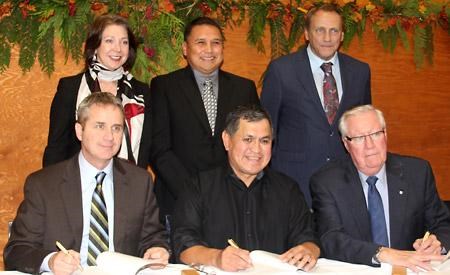by Laura Walz [email protected] A break in the clouds letting the sun shine, eagles circling overhead, a long list of dignitaries, hundreds of smiling faces and tears of joy all marked the initialling of Tla’Amin (Sliammon) First Nation’s final agreement.
An estimated 350 people attended the celebration on Friday, October 21 at the Salish Centre in Tla’Amin. Tla’Amin, Canada and BC chief negotiators initialled the final agreement, which will become the treaty if a majority of Tla’Amin members ratify it.
MP John Duncan, minister of aboriginal affairs and northern development, MLA Mary Polak, minister of aboriginal relations and reconciliation, Sophie Pierre, chief commissioner of the BC Treaty Commission, Tla’Amin Chief Clint Williams, Vern Pielle, president of Sliammon Treaty Society, City of Powell River Mayor Stewart Alsgard and Tsawwassen First Nation Chief Kim Baird addressed the gathering during a ceremony that was emceed by Dr. Evan Adams, a Tla’Amin band member who is the province’s aboriginal health physician advisor. Tla’Amin singers and dancers performed during the event, which marked the conclusion of negotiations between Tla’Amin and federal and provincial negotiators.
Williams welcomed everyone to the celebration and pointed out there had been many changes in the community since the treaty process began, including a change in demographics. Over 50 per cent of the Tla’Amin population is under the age of 25. “This treaty has come with many challenges and there will be many more challenges to come,” he said. “As a result of this treaty, we’ve met some really great people, but also some family relationships and friendships have been put to test because Sliammon people are passionate about land and resources and overall care of the community.”
Duncan reminded the gathering that he was the MP when Tla’Amin first entered the treaty process in 1994. He represented the riding that was then named North Island-Powell River from 1993 to 1997.
The final agreement will help achieve comprehensive benefits that promote health, economic prosperity and quality of life for Tla’Amin members, said Duncan. “As a minister, I am very happy when communities are empowered, no longer subject to the Indian Act and I no longer make decisions that I don’t think are appropriate for me to be making,” he said.
Partnerships with first nations are going to unleash major economic benefits for British Columbia and increase opportunities for first nations communities, Polak said. “For Tla’Amin, this treaty will bring direct economic benefits, as well as the all important certainty that economic development is not going to come at the expense of your culture and your traditions. For Tla’Amin, Canada and British Columbia, this agreement is a new relationship.”
Pierre recognized the amount of work that went into reaching the agreement and how much there is still to do between now and the ratification vote, expected to take place in mid-June, 2012. She mentioned her recent comments about the treaty process in BC, which she said needs to be shaken up. “The need for treaty is there. It is good for us; we need to reach these treaties, for all of us, for British Columbians and Canadians.”
The commission has said that the process itself needs to “get some more teeth,” Pierre said. “It needs to become something that will allow all the first nations that are in the process to be able to celebrate the way you are here today.”
After 20 years and $533 million, the treaty process has resulted in only two treaties that have been implemented, Tsawwassen and Maa-nulth first nations.
Baird spoke directly to the leaders who will be working to inform the community about the treaty agreement in the 30 weeks leading up to the ratification vote. “Your challenge will be to provide the right information in the right way to allow your people to make a decision for themselves. Likewise, it’s up to all the members of the community to become informed so you can make an informed decision.”
Tla’Amin’s treaty contains provisions for self-government and financial and land transfers. The land component consists of about 8,322 hectares of treaty lands, comprised of 1,917 hectares of Indian Reserves and 6,405 hectares of Crown land.
Tla’Amin will receive a capital transfer of about $29.7 million over 10 years, economic development funding of approximately $6.9 million and a fishing vessel fund of $250,000. BC and Canada will each provide $331,292 annually in resource revenue sharing for 50 years.
The treaty also provides for the ownership of forestry resources, as well as domestic fishing, gathering and harvesting rights.
Through self-government, first nations who have adopted a treaty exercise law-making authority over matters integral to their community, such as health, education and child welfare.
Roy Francis, Tla’Amin chief negotiator, said the jewel of the package is the land base. “Sliammon is going to be owning beyond 8,000 hectares of land. About 70 kilometres of that is waterfront land.”
The governance authorities will make Tla’Amin lawmakers over the land base, Francis added. “We’re going to be clearly in charge of how those resources are going to be managed and used.”
The financial transfers are significant, Francis also said. “Sliammon has experienced some really challenging financial hardships over the last few years. The package that we’ve signed off on basically cures that.”



